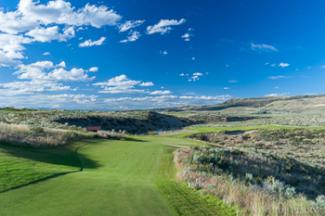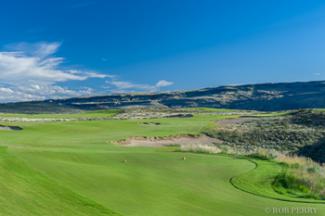Featured Golf News
Gamble Sands - A Winning Combination in Remote Eastern Washington
Before playing it in mid-October 2014, I heard nary a quibble about Gamble Sands, the new wall-to-wall fescue course designed by David McLay Kidd on the outskirts of small-town Brewster, Wash. To a person, all comments were overwhelmingly positive.

The Ninth Hole at Gamble Sands
(Photo by Rob Perry)
My informal poll included a few golf writers, fellow club members and others in the golf industry. They were, for the most part, all Washingtonians. We Evergreen Staters have been on a bit of a roll ever since the USGA pegged Chambers Bay near Tacoma as the site of the 2015 U.S. Open. And now Gamble Sands in the much-less-populated, arid desert half of our state opens to national acclaim.
So I followed up on the positive vibes emanating from this remote place about 200 miles east of Seattle, where a longstanding local fruit-growing family, the Gebbers, converted some of their massive landholdings into a links-style layout high above the mighty Columbia River.
Back in 2007 I began tracking the development of a course by Gebbers Farms, which was founded in 1885 and now grows 5,000 acres of apples, making it one of the largest contiguous apple orchards in the world. (The Gebbers name is also known state-wide as various family descendants contributed to Brewster High School's boys' teams winning eight Class A state basketball championships between 1974 and 2007 and four girls' titles between 1999 and 2013.)

The Sixth at Gamble Sands Offers Amazing Panoramas
(Photo by Rob Perry)
The original plan involved an 18-hole course designed by Perry Dye on the opposite (west) side of the Columbia. Three holes were completed there on a sloped hillside (observable from Gamble Sands, the course might be completed at a future date) at an expense of $1.5 million, before the country's lagging economy put the project on hold.
Then Kidd, designer of the original Bandon Dunes course who leveraged that much-heralded creation into over a dozen more completed tracks, came on board. Scotsman that he is, Kidd was smitten with Gebbers' new 300-acre site, which occupies a striking, treeless plateau overlooking the river immortalized in Woody Guthrie's song, "Roll On, Columbia, Roll On," one blessed with deep layers of porous, natural sand. In other words: the perfect spot for a massive and rollicking golf links.
After designing tough courses 380 miles to the south of Brewster in Bend, Ore. - Tetherow - where he now makes his home, and in St. Andrews, Scotland - Castle - Kidd decided golfers didn't need to be hammered over the head with multiple layers of technical difficulty that cause headaches and high scores. At Gamble Sands - a name derived generations ago when John Gebbers married Martha Gamble - he switched gears, creating a course that made the game considerably friendlier.

Example of the Broad Fairways at Gamble Sands;
Here's the Seventh Hole
(Photo by Rob Perry)
A month before my visit to Brewster, I did a series of articles on the resurgence of golf in Bend. Of his design at Tetherow (sometimes jokingly called "Death-arow"), Kidd told me in one of the installments (see the story link below): "I just think that golf design in general (in 2008 when Tetherow opened) was gravitating toward ever more difficult courses, where the resistance to scoring was a major component of the magazine ranking systems and so those courses that were hard were deemed great; those that were not, were not . . . In retrospect, it was not good for Tetherow or golf."
Kidd's updated philosophy is on full display at Gamble Sands, which even from its way-back tees at 7,169 yards has a course rating of 74.2 and relatively low Slope of 128 (the course record of 10-under 62 was set soon after it opened by University of Washington golfer, Frank Garber).

The Landforms on the 15th Hole Crafted by Scottish
Golf Architect David McLay Kidd
(Photo by Rob Perry)
With such outstanding soil, natural movement of the property and an unlimited irrigation source in the Columbia River, Kidd knew that the onus was on him to produce an interest-piquing but accessible test. "There were no excuses," he told Golf Digest's Ron Whitten in November, when the magazine declared Gamble Sands the Best New Course to open in the U.S. in 2014.
"I couldn't blame it on the real estate or lack of water. If it turned out crap, it would be all my fault," Kidd confided.
The architect succeeded on all levels, constructing a fun and intimidation-free venue for a mere $2.1 million. Since it opened, people - mostly from Seattle, Spokane and eastern British Columbia's Okanagan region so far - have flocked here. According to staff, the facility, which opened in August 2014, met its first-year projections within a mere two months.

The Bowl-Shaped Green at Gamble Sands' Par-3 16th
(Photo by Rob Perry)
My friend Webb and I made the four-hour trip from Seattle over Highway 2 through the Bavarian-themed town of Leavenworth (be sure to stop here and play Enzian Falls, a natural-turf, 18-hole putting course) and into central Washington's fruit-rich region before veering north and driving beside the millennia-old Columbia River, carved by ancient glaciers, to Brewster.
Webb said it best after we finished our round: "I want to go back."
A second helping of Gamble Sands should help the scorecard as first-timers will find several greens fronted by tall humps that boggle distance measurements. Bunkers placed 50-75 yards before the massive putting surfaces also play havoc with club selection as do the sundry humps and hollows throughout the course.
But there are three drive-able par-4s, and the tight lies of the green surrounds allow using all manner of clubs - putters, 6-irons, hybrids - to attack the pins. And it's almost impossible to lose a golf ball on these massive - upwards of 80-yard-wide - fairways. The bunkers, filled with local sand, aren't excessively deep and penal either.

Gamble Sands Overlooks the Columbia River
(Photo by Larry Lambrecht)
The turf, tended by appropriately-named superintendent Chip Caswell, is a lush-green color that is quite unlike, say, the tawny fescue found at similarly-grassed, west-of-the-Cascade-Mountains' venues Chambers Bay, alongside Puget Sound, and Bandon Dunes, on the Pacific Ocean.
Golfers will find perfect lies at Gamble Sands. There are no cart paths disturbing the verdure, and walkers are encouraged. New signage is needed, however, to help locate the next tees, many of which aren't elevated and blend seamlessly into fairways.
Future plans include cabins - which will not be observable from the golf course - that will house 40 to 50 overnight guests. No private residences will be built.
In sum, Gamble Sands is just the right kind of fun golf course the troubled golf industry now needs, one that's downright enjoyable and asks you to return for more.
For additional information, visit http://gamblesands.com. For the installment about Tetherow, visit (http://www.cybergolf.com/golf_news/central_oregon_looks_to_return_to_glory_days_part_2_tetherow.

July 2014 Fire at Alta Lake Golf Course
(Photo by Bob Spiwak)
The Fires of Summer 2014
Though Gamble Sands and environs weren't affected, this part of the north-central Washington was ablaze in the summer of 2014 when massive lightning-caused wildfires stormed through. Particularly hard hit were the town of Pateros - about 15 minutes south of Brewster - and the Alta Lake area farther to the west, which saw many of the homes around its eponymous 18-hole golf course destroyed. (Leavenworth was also threatened by a separate 13,900-acre inferno called the Chiwaukum Creek Fire.)
The 250,000-acre Carlton Complex blaze in mid-July swept across major highways and everything else in its path as it destroyed over 300 homes and left hundreds homeless.
Libby is the likeable bartender at Gamble Sands' small but comfortable clubhouse, one that boasts magnificent Columbia River vistas through its towering windows. Like many of the course's staff, she lives in Pateros. Libby told me that when the fires forced evacuations of residents she and her family retreated to a parking lot beside the river and watched helplessly as their home on the hill above them burned to the ground.
Other residents shared similar stories. The only vestiges of life following the swift-moving fire at Alta Lake - a quirky layout featuring an original nine holes with steep, two-tiered greens and a newer, more traditional side that crosses a broad chunk of land - were its irrigated fairways. Neighboring houses were leveled by the fast-moving fires and the course's golf carts were literally melted by temperatures estimated at 2,500 degrees F.
The Carlton Complex fire was the largest in Washington history, surpassing the famed Yacolt Burn of 1902. While visiting this section of the state, a place where I grew up, I saw many blackened remnants of the fires in the desert-sagebrush, the randomness of the destruction especially chilling.
The fires of 2014 might have destroyed buildings and personal belongings, but not the will of the people.
Jeff Shelley is the editorial director of Cybergolf.
Story Options
 |
Print this Story |
